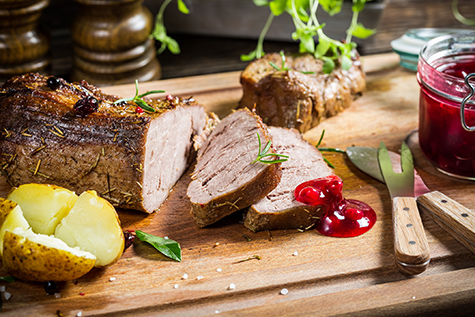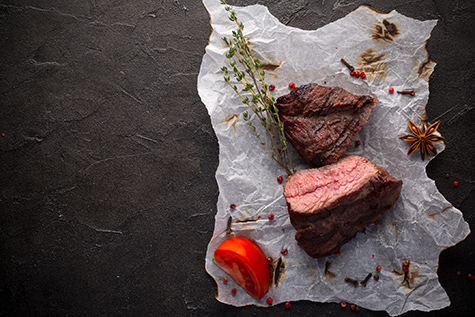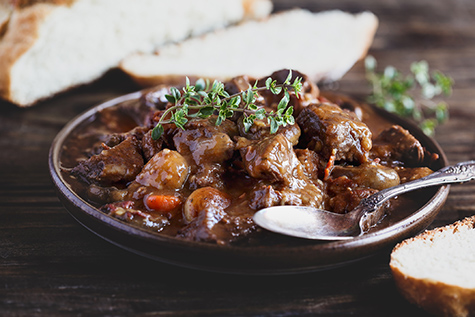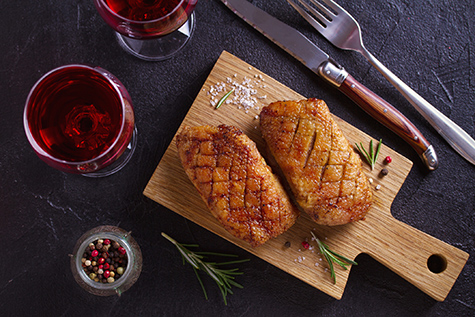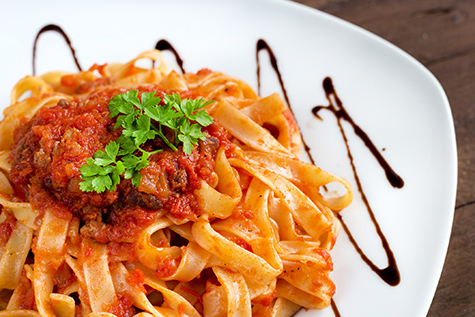Try Some Different Meats: Are You Game for Game?

It’s 2021, a new year and time to try something new — game! Don’t knock it till you’ve tasted some of these recipes. Game meat is leaner and more nutritious than ‘factory farmed’ meat. The meat we purchase in grocery stores, even if it is organic and pasture-raised, is often given feed (such as corn and other grains) the animals wouldn’t eat on their own. Game is high in iron and contains higher levels of many beneficial nutrients including vitamin E, beta carotene, zinc, vitamin B(6) and selenium. Selenium is an important nutrient that is hard to get in a Westernized diet and helps protect cells from damage caused by free radicals. Wild red meat such as venison is high in omega-3 fatty acids which help protect your heart health. In addition, wild game is ideal for those following a paleo or ‘cave man’ diet.
Game meat doesn’t have to taste ‘gamey.’ Much of the unpleasant strong flavor comes from improper butchering or preparation, so be sure to get your game meat from a reputable source and use it in recipes that enhance its flavor. D’Artagnan is a company from which you can order game meat and sustainably raised pork, chicken, beef and more. Other companies that raise and source all-natural game and other meats are Fossil Farms, Broken Arrow Ranch and Farm Foods.
Ostrich Steak
Ostrich meat has been readily available for over 25 years, but it’s still not something you’ll necessarily find at your local Food 4 Less. Ostrich meat is dark and pinkish with a subtle flavor, more like beef than poultry. It cooks quickly and can be overwhelmed if you use too strong flavors. Fry it with lots of butter and use a light wine sauce or marinade.
It’s important not to cook it past rare to medium-rare. And like a turkey or a beef roast, letting it “rest” before slicing to give the meat time to reabsorb the juices that would otherwise be lost. That keeps the ostrich meat juicier and tastier.
Asian-Style Marinade for Ostrich Steak
Serves 2
Ingredients
2 ostrich steaks, about 6 oz. each
2 Tbs. soy sauce
1 tsp. ginger, grated
1 Tbs. sesame Oil
1 Tbs. rice wine
2 Tbs. pineapple juice
Instructions
1. Rub the ostrich steak with a mixture of garlic, freshly ground black pepper and oil then let it sit in the fridge for up to 5 hours.
2. Remove from the refrigerator and pat dry with a paper towel.
3. Prepare the marinade and set aside.
4. Heat a skillet to hot, add a little olive oil or butter.
5. Cook steaks for 2 ½ minutes per side.
6. Remove and place on a warm plate. Cover and let rest for 10 minutes.
7. Add the marinade to the hot skillet and cook uncovered until it thickens a bit.
8. Slice steaks across the grain.
9. Pour marinade over the steaks.
10. Serve with rice and vegetables.
Venison refers to the meat of antlered animals such as deer, elk and caribou. It’s high in protein, iron and vitamin B, but low in fat. To enjoy venison, you don’t have to eat Bambi’s mother from the forest. Venison is raised humanely and commercially on a limited basis in open fields and pastures. The animals move and graze much as they would in the wild. The ‘wild’ flavor of venison is directly related to what the animal eats. Corn fed deer will have a milder flavor than those that eat acorns or sage. The ‘gamey’ flavor is more noticeable in the fat. By carefully removing the fat and connective tissue, you lessen the ‘gamey’ taste.
People describe venison having a rich or earthy flavor, often imbued with the taste of the acorns, sage and herbs that the deer enjoyed during its life. Because it’s a very lean meat, it’s also less juicy and succulent than beef, but also smoother and firmer. The best ways to prepare venison are in marinades or stews.
Venison Bourguignon
Serves 8-10
This French term means, ‘venison as prepared in Burgundy.’ You are probably familiar with the beef version. This rich stew of venison, red wine, herbs and butter is the perfect way to enhance the deer meat. The bourguignon sauce bathes the tender veggies and melt-in-your-mouth morsels of deer meat.
Ingredients
3 Tbs. olive oil, divided
8 oz. chopped bacon
3 lb. deer roast meat cut into 2-inch chunks
6 carrots cut into large chunks
2 onions roughly chopped
6 cloves garlic, smashed
1 lb. cremini mushrooms, halved
½ cup brandy
3 ¼ cups dry red wine
2 cups venison or beef stock
2 Tbs. tomato paste
1 bouquet if fresh herbs: fresh herb bouquet with thyme, rosemary, tarragon and a bay leaf
4 Tbs. butter, softened
1/3 cup flour
3 lb. baby golden potatoes (like Yukon), halved
Salt and freshly ground black pepper
Instructions
1. Heat 1 Tbs. oil in a large pot or Dutch oven. Add the bacon and cook over medium heat until brown and crisp. Remove with a slotted spoon and set aside.
2. Pat the venison chunks dry with a paper towel and salt and pepper to taste. Brown the meat on all sides. Then remove with a slotted spoon.
3. Add the onions, garlic, and carrots to the pot. Cook and stir for several minutes until the onions have softened, then add the mushrooms and cook another 5-10 minutes.
4. Add all meat back to the pot; add brandy, wine, stock, and tomato paste. Add 1 tsp. salt and
1 tsp. ground pepper and stir well. Then add the herb bouquet and cover.
5. Bring to a boil, then lower the heat and simmer for approximately 3 hours until the venison is very tender.
6. In the last hour of simmering, preheat the oven to 450 degrees F.
7. Place the mini potatoes on a rimmed baking sheet and toss with 2 Tbs. oil, salt and pepper.
8. Roast for 35-45 minutes until tender, tossing once in the middle.
9. Once the venison is tender, in a separate pan, mix half a stick of softened butter with 1/3 cup of flour. Use a fork to press into a paste.
10. Slowly stir the butter mixture into the stew until the desired thickness in reached.
11. Salt and pepper to taste if needed.
12. Serve with the potatoes.
Roast Wild Duck
Serves 4
Fun fact: The only way to get a hold of wild duck in this country is by shooting it yourself or having a generous (and successful!) hunter friend give you one. The law states that certain migratory birds can be hunted in season, but not sold. Duck hunting season in the U.S. is from the end of September until the end of January, so the chance of sourcing fresh wild duck right now is slim.
However, there are specialty breeds of ducks available from the aforementioned websites and in a pinch, you can pick up a domestic duck from a butcher. Duck meat is darker than chicken and has a taste more like other red meat. It has more fat which, when cooked correctly, provides a pleasant tender, moist protein. The taste of duck can be compared to liver or steak. Duck may be considered red meat in the kitchen, as it’s often served medium rare and remains dark during cooking. When cooked, the juices run red, not clear, more like a juicy red steak.
Ingredients
2 small whole Teal ducks (about 1 lb. ea.)
2 Tbs. extra virgin olive oil
1 tsp. coarse sea salt
6 sprigs of rosemary
1 medium onion, quartered
1 medium apple, cored and quartered
2 tsp. whole cloves
1/3 cup dry sherry
¼ cup cream
Instructions
1. Preheat oven to 450 degrees F.
2. Rinse the ducks with water. Thoroughly pat dry with paper towels.
3. Lightly stuff each duck with 3 sprigs of rosemary, 2 apple slices with a few cloves poked in them to hold them in place and 2 quarters of onion.
4. Cover the duck inside and out with olive oil. Sprinkle all sides of the duck with coarse salt.
5. Roast the duck breast side up on a roast rack in a roasting pan. Place on the middle rack of the 450 degrees F oven. Immediately lower the heat to 425 degrees F.
6. Cooking times depend on the variety of the duck. Teal ducks typically weigh less than a pound and cook in 10-15 minutes. Larger ducks (2lb. and up) can take up to 1 hour-1hour 25 minutes. Take care not to overcook.
7. Cook until the duck reaches an internal temp (in the thigh) of 135 degrees F. If you error on the underdone side, you can always put the bird back in the oven for a few more minutes.
8. To test doneness, take the bird out of the oven and cut a part of it with the tip of a sharp knife. The juices will run red and the meat will also be red. The meat should look like a rare (not raw) steak. The more the meat is cooked beyond the rare stage, the more gamey it will taste.
9. Remove the duck from the oven and place it on a warm plate to rest, breast side down, for 10 to 15 minutes.
10. While the duck is resting, if there are drippings in the roasting pan, pour off the excess fat (save for another recipe). Remove the cloves from the apple and chop the apple and onion.
11. Place the roasting pan on the stovetop, heat to medium, and deglaze with a little dry sherry; add the apple and onion and stir well.
12. Scrape up the browned bits with a metal spatula. Use a metal whisk to break up the bits even further into the sherry.
13. Reduce the sherry mixture and then add the cream; pour into a gravy serving dish or small bowl.
14. Serve with the duck as a sauce.
Wild Boar Ragu Bolognese
4-6 servings
Wild boars are reclusive and fierce which have made them an appealing challenge to hunters. They are native to much of Eurasia and North Africa but have been introduced to the Americas and Oceania. They are one of the widest-ranging species in the world. Free-roaming boar yields meat with more flavor and less fat than regular pork. The meat is dark, and flavor is strong, nutty, rich but not gamey. Some describe the meat as tasting a bit like dark meat turkey.
Wild boar has been used in stews and pasta dishes in Tuscan cuisine for centuries. Interestingly, in Italy these wild pigs have bred with domestic swine and have overrun the countryside in certain places, causing harm to crops and farmland.
The word, ragu describes a thick, full-bodied meat sauce that also contains tomatoes, vegetables, and wine. Note: because of the slow cooker, this dish is a two-day process.
Ingredients
For the slow-cooked boar:
3 lb. wild boar shoulder
½ cup diced carrots
1 bunch Italian flat parsley
½ cup chopped onions
2 peeled, chopped garlic cloves
1 15 oz. can diced tomatoes in juice
½ cup red wine (Chianti)
Directions for slow cooked wild boar:
1. Cut up the meat so it fits into a crock pot.
2. Sear the meat on all sides in a large skillet with olive oil. Season with sea salt and pepper.
3. Put the meat, vegetables, diced tomatoes and wine in the pot.
4. Cook for 7 hours. The meat should be fall apart tender. You can freeze the extra meat and use for sandwiches later.
Ingredients for the ragu:
1 lb. slow cooked chunks of wild boar shoulder
4 cloves garlic peeled and chopped
2 cups red wine (Chianti)
2 Tbs. olive oil as needed
2 small carrots scrubbed and diced
2 stalks celery diced
1 medium onion diced
1 28 oz. can crushed tomatoes
1 cup vegetable stock
2 Tbs. chopped basil
2 lb. pappardelle (flat, long noodles)dry or fresh pasta
2 Tbs. Parmigiano Reggiano for serving
sea salt and pepper to taste
Instructions
1. In a large skillet add olive oil, diced onion, carrots, celery and garlic. Sauté for 3-5 minutes until vegetables are slightly softened.
2. Add red wine, tomatoes and stock, stirring well. Cook over medium high heat until it begins to lightly boil then reduce heat to low and simmer for 1 hour.
3. Add slow cooked wild boar chunks to the sauce and allow to continue to cook for at least another hour, using a whisk to break up the pork as it cooks. Pork should be very small pieces.
4. If sauce is too thick add additional stock. The sauce it should be stew like; loose but not wet.
5. Cook pappardelle per instructions on box. Mix pasta with a little sauce, then top with additional sauce and Parmigiano Reggiano and serve.
